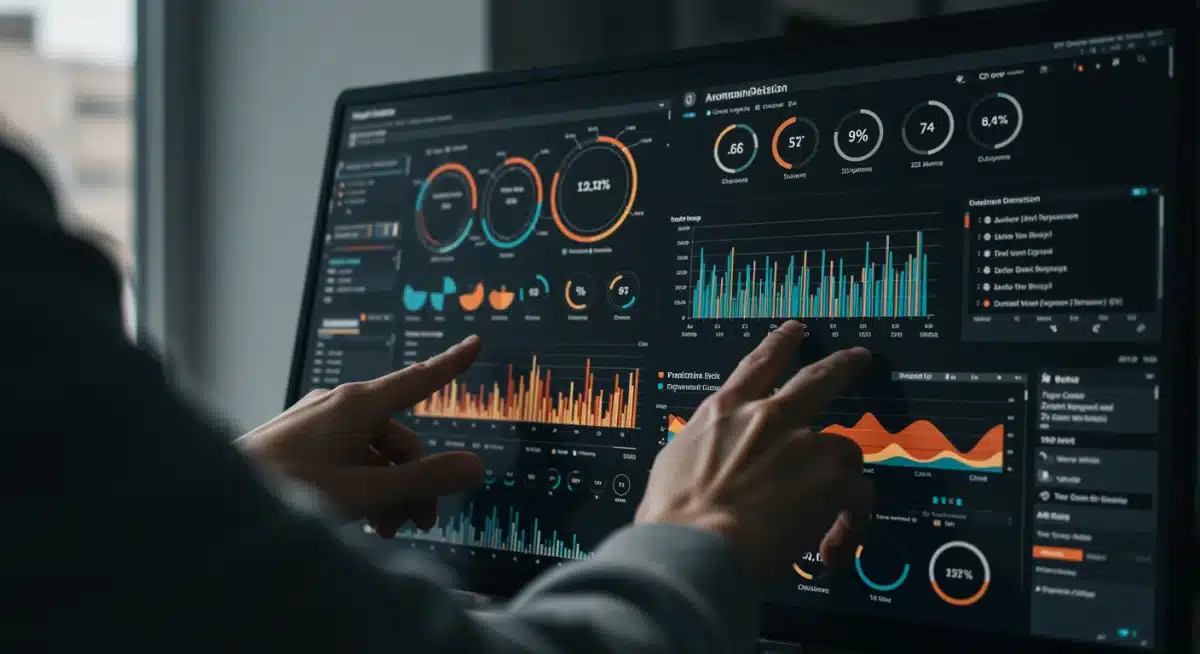AI in Cybersecurity: Protecting US Businesses from Threats in 2025

AI in cybersecurity, leveraging predictive analytics, is becoming indispensable for US businesses to proactively defend against the rapidly evolving landscape of emerging cyber threats anticipated in 2025.
As 2025 approaches, US businesses face an increasingly complex and aggressive cyber threat landscape. The critical role of AI in Cybersecurity: Protecting US Businesses from Emerging Threats in 2025 with Predictive Analytics cannot be overstated, as organizations race to implement advanced defenses against sophisticated attacks.
The Escalating Cyber Threat Landscape for US Businesses
The digital frontier continues to expand, bringing with it an unprecedented surge in cyber threats targeting US businesses. These aren’t just isolated incidents; they represent a coordinated, evolving assault on critical infrastructure, intellectual property, and customer data. Understanding the scale and sophistication of these attacks is the first step toward effective defense.
Recent reports indicate a sharp increase in state-sponsored cyber espionage and financially motivated ransomware attacks. Cybercriminals are now leveraging advanced AI tools themselves, making traditional signature-based detection systems increasingly obsolete. This arms race necessitates a proactive, intelligent response.
Advanced Persistent Threats (APTs)
Advanced Persistent Threats (APTs) are a primary concern for US businesses, characterized by their stealth and long-term objectives. These sophisticated attacks often involve multiple stages, from initial compromise to data exfiltration, remaining undetected for extended periods. Their targets are typically high-value assets, making the impact severe.
- Targeted Reconnaissance: Attackers meticulously research their targets.
- Multi-stage Attacks: Involve various techniques for initial access, privilege escalation, and lateral movement.
- Evasion Techniques: Designed to bypass standard security measures and remain hidden.
- Data Exfiltration: Focus on stealing sensitive information over time without detection.
Ransomware and Supply Chain Vulnerabilities
Ransomware continues to be a lucrative venture for cybercriminals, with attacks becoming more targeted and disruptive. Beyond direct financial demands, the collateral damage to operations and reputation can be immense. Compounding this, supply chain vulnerabilities present a significant entry point for attackers, exploiting weaknesses in third-party vendors to compromise larger organizations. The interconnectedness of modern business ecosystems means a breach in one link can have cascading effects.
AI’s Transformative Role in Cybersecurity Defense
Artificial Intelligence is no longer a futuristic concept but a vital component in modern cybersecurity strategies. Its ability to process vast amounts of data, identify patterns, and learn from experience offers a significant advantage in detecting and mitigating threats that human analysts alone cannot keep pace with. AI-driven systems are fundamentally changing how businesses approach defense.
The sheer volume of daily cyber events makes manual analysis impossible. AI algorithms can analyze network traffic, user behavior, and system logs in real-time, pinpointing anomalies that indicate a potential breach. This speed and scale are critical in an environment where every second counts.
Machine Learning for Anomaly Detection
Machine learning, a subset of AI, excels at identifying deviations from normal patterns. By training on historical data, these models can establish baselines for typical network activity, user behavior, and system processes. Any significant departure from these baselines triggers an alert, indicating a potential threat. This approach moves beyond known signatures to detect novel and evolving attack vectors.
- Behavioral Analytics: Monitors user and entity behavior for suspicious activities.
- Network Traffic Analysis: Scans for unusual data flows or communication patterns.
- Endpoint Detection and Response (EDR): Identifies malicious activities on individual devices.
- Insider Threat Detection: Flags unusual activities by internal users.
Automated Threat Response and Orchestration
Beyond detection, AI is increasingly enabling automated threat response. Once a threat is identified, AI-powered systems can initiate pre-defined actions, such as isolating affected systems, blocking malicious IP addresses, or revoking user credentials. This automation significantly reduces response times, minimizing the window of opportunity for attackers and limiting potential damage. Security Orchestration, Automation, and Response (SOAR) platforms, heavily leveraging AI, streamline complex security workflows.
Predictive Analytics: Anticipating Future Cyber Threats
Predictive analytics stands as a cornerstone of advanced cybersecurity, enabling US businesses to move from reactive defense to proactive threat anticipation. By analyzing historical data, current threat intelligence, and emerging attack trends, these systems forecast potential vulnerabilities and attack vectors before they materialize. This foresight is invaluable in a landscape where new threats emerge daily.
The power of predictive analytics lies in its capacity to identify subtle indicators that might otherwise go unnoticed. It correlates disparate pieces of information, such as global attack patterns, software vulnerabilities, and geopolitical shifts, to construct a comprehensive threat model specific to an organization’s risk profile. This allows for strategic resource allocation and fortification of the most probable targets.
Data-Driven Threat Intelligence
Effective predictive analytics relies heavily on robust data-driven threat intelligence. This involves aggregating information from various sources, including dark web forums, security research, industry reports, and internal incident logs. AI processes this vast dataset, extracting actionable insights about new malware strains, attack methodologies, and adversary profiles. This intelligence forms the foundation for anticipating future attacks.
- Global Threat Feeds: Integrates data from worldwide cyberattacks.
- Vulnerability Databases: Monitors known and zero-day vulnerabilities.
- Dark Web Monitoring: Tracks discussions and sales of exploit kits.
- Internal Incident Data: Learns from past breaches and near-misses.
Risk Scoring and Prioritization
Predictive analytics assigns risk scores to various assets, systems, and potential vulnerabilities within an organization. This allows security teams to prioritize their efforts, focusing on areas with the highest likelihood of being targeted or those that would incur the most significant damage if compromised. By understanding which assets are most at risk and from what type of attack, businesses can strategically deploy resources for maximum impact, optimizing their security posture.
Implementing AI and Predictive Analytics in 2025
For US businesses, the successful integration of AI and predictive analytics into their cybersecurity frameworks in 2025 is not merely an option but a strategic imperative. This implementation requires a phased approach, starting with a clear understanding of current security gaps and the specific goals AI can help achieve. It’s about building a resilient, adaptable defense system.
Organizations must move beyond simply acquiring AI tools. True success comes from integrating these technologies with existing security operations, ensuring seamless data flow, and training security personnel to leverage AI-driven insights effectively. A holistic strategy is essential for maximizing the benefits of these advanced capabilities.

Phased Adoption Strategy
A phased adoption strategy is crucial for successful AI integration. Businesses should start with pilot projects, focusing on specific high-impact areas like threat detection or vulnerability management. This allows for testing, refinement, and demonstrating tangible value before scaling across the entire enterprise. It also helps in identifying and addressing potential challenges early on.
- Pilot Programs: Implement AI in controlled environments for specific use cases.
- Incremental Rollout: Expand AI capabilities step-by-step across departments.
- Continuous Monitoring: Regularly assess AI system performance and effectiveness.
- Feedback Loops: Incorporate insights from security teams for ongoing optimization.
Addressing Data Privacy and Ethical AI Concerns
While AI offers immense benefits, its implementation also raises critical concerns regarding data privacy and ethical considerations. Businesses must ensure that AI systems are trained on appropriate, anonymized data and that their use complies with privacy regulations. Transparency in AI decision-making processes and mitigating algorithmic bias are also paramount to maintaining trust and avoiding unintended consequences, particularly when handling sensitive information.
Challenges and Considerations for US Businesses
While the promise of AI in cybersecurity is immense, its implementation is not without significant challenges for US businesses. These hurdles range from technical complexities to human resource limitations, requiring careful planning and strategic investment. Overcoming these obstacles is key to unlocking the full potential of AI-driven defenses.
The rapidly evolving nature of both cyber threats and AI technology means that solutions must be agile and continuously updated. Static deployments will quickly become ineffective. Furthermore, the integration of AI into existing, often legacy, systems can be a complex and resource-intensive undertaking, demanding specialized expertise.
Talent Gap in AI Cybersecurity
One of the most pressing challenges is the significant talent gap in AI cybersecurity. There is a shortage of skilled professionals who possess expertise in both advanced AI technologies and deep cybersecurity principles. This makes it difficult for businesses to effectively implement, manage, and optimize AI-driven security solutions. Investing in training and upskilling existing teams, or attracting new talent, is a critical component of any successful AI strategy.
- Specialized Skill Shortage: Lack of professionals proficient in both AI and cybersecurity.
- Training Programs: Need for robust internal and external training initiatives.
- Retention Strategies: Developing incentives to keep skilled AI security experts.
- Cross-functional Teams: Fostering collaboration between AI developers and security analysts.
Integration with Legacy Systems
Many US businesses operate with a mix of modern and legacy IT infrastructure. Integrating cutting-edge AI and predictive analytics solutions with older systems can be a formidable task. Compatibility issues, data silos, and the sheer complexity of retrofitting new technologies into established environments often create significant roadblocks. A strategic approach to modernization and API-driven integration is often required to bridge these technological divides effectively.
The Future of Cyber Resilience: 2025 and Beyond
Looking beyond 2025, the trajectory for cybersecurity firmly points towards increasingly sophisticated AI integration. The goal is not just to detect and respond to threats but to build truly resilient systems that can anticipate, adapt, and even self-heal. This vision of cyber resilience relies heavily on continuous innovation in AI and predictive analytics, creating a dynamic defense posture.
As cybercriminals continue to innovate with their own AI tools, the defensive capabilities must evolve even faster. The future will see AI playing a more autonomous role, not just assisting human analysts but taking decisive actions based on learned intelligence. This shift will fundamentally redefine the roles within security operations centers.
Autonomous Security Operations
The concept of autonomous security operations is gaining traction, where AI systems can independently detect, analyze, and respond to threats with minimal human intervention. This vision involves AI agents monitoring networks, identifying anomalies, and executing countermeasures at machine speed. While full autonomy is still some way off, gradual steps towards more automated decision-making are already being implemented.
- Self-healing Networks: Systems that can automatically repair vulnerabilities.
- AI-driven Incident Response: Automated containment and remediation of threats.
- Predictive Patching: AI identifying and patching vulnerabilities before exploitation.
- Proactive Threat Hunting: AI actively searching for nascent threats within networks.
Collaboration and Information Sharing
No single organization can fight cyber threats alone. The future of cyber resilience hinges on enhanced collaboration and information sharing across industries, government agencies, and international partners. AI can facilitate this by anonymizing and correlating threat intelligence data from multiple sources, creating a more comprehensive and real-time picture of the global threat landscape. Shared AI models and collective learning will amplify defensive capabilities for all.
| Key Point | Brief Description |
|---|---|
| Emerging Threats 2025 | US businesses face escalating state-sponsored cyber espionage, ransomware, and supply chain attacks, often leveraging advanced AI. |
| AI’s Role in Defense | AI, particularly machine learning, is vital for real-time anomaly detection and automated threat response, surpassing human capabilities in scale. |
| Predictive Analytics | Utilizes data-driven threat intelligence to forecast vulnerabilities and attack vectors, enabling proactive defense and risk prioritization. |
| Implementation Challenges | Key hurdles include a talent gap in AI cybersecurity, integrating with legacy systems, and addressing data privacy concerns. |
Frequently Asked Questions About AI in Cybersecurity
The primary benefit is AI’s ability to process vast amounts of data in real-time, enabling rapid anomaly detection and predictive threat anticipation. This significantly reduces response times and enhances proactive defense against emerging and sophisticated cyberattacks, safeguarding critical assets more effectively.
Predictive analytics leverages historical data and current threat intelligence to forecast potential attack vectors and vulnerabilities. This allows US businesses to identify and mitigate risks before attacks occur, prioritizing defenses and allocating resources strategically to fortify against anticipated threats in 2025.
Key challenges include a significant talent gap in AI cybersecurity specialists, difficulties integrating new AI systems with existing legacy IT infrastructures, and crucial concerns regarding data privacy, ethical AI use, and potential algorithmic bias. These require careful planning and investment.
While AI is moving towards more autonomous functions like threat detection and automated responses, full automation of all cybersecurity operations is not yet a reality. Human oversight and expertise remain critical for complex decision-making, strategic planning, and addressing novel, unseen threats that require nuanced judgment.
Collaboration and information sharing are vital because no single entity can combat global cyber threats alone. AI can facilitate anonymized threat intelligence exchange across industries and governments, creating a collective defense mechanism that amplifies overall resilience and protective capabilities against widespread campaigns.
What Happens Next
The trajectory for AI in cybersecurity indicates a rapid acceleration in deployment and sophistication. US businesses must prepare for a future where AI-driven defenses are not just an advantage but a fundamental necessity. Expect continued innovation in autonomous security operations and a greater emphasis on collaborative threat intelligence sharing mechanisms. Regulatory bodies are also likely to introduce new guidelines addressing the ethical deployment and data privacy implications of these powerful technologies, shaping how businesses leverage AI to protect their digital assets.





